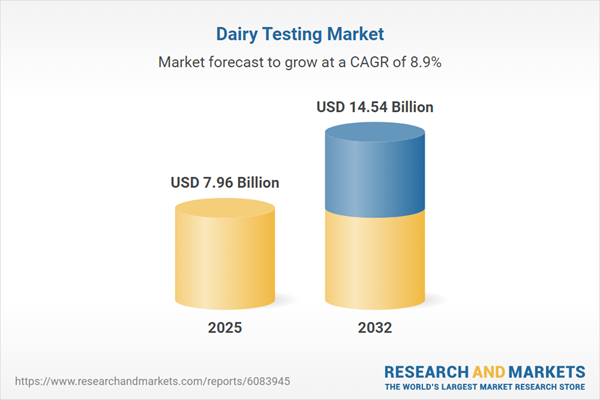Speak directly to the analyst to clarify any post sales queries you may have.
The dairy testing market is rapidly transforming as industry leaders, regulators, and service providers seek more robust solutions for quality assurance, food safety, and global compliance. Continuous technological innovation, intensifying regulatory demands, and growing consumer expectations are elevating the role of advanced testing protocols within modern dairy operations.
Market Snapshot: Dairy Testing Market – Growth, Trends, and Outlook
The Dairy Testing Market grew from USD 7.35 billion in 2024 to USD 7.96 billion in 2025. It is expected to continue growing at a CAGR of 8.89%, reaching USD 14.54 billion by 2032.
Scope & Segmentation of the Dairy Testing Market
This report delivers in-depth coverage of the dairy testing landscape, segmenting the market across core testing types, product categories, technological approaches, primary applications, and global regions. Detailed segmentation includes:
- Testing Type: Quality testing (microbial, nutritional, organoleptic), safety testing (adulteration, allergens, pathogen, pesticide residue)
- Product Type: Butter and ghee, cheese, cream, ice cream, infant formula, milk powder, processed milk (flavored, pasteurized, UHT), raw milk, yogurt and cultured products
- Technology: Rapid testing (chromatography & spectrophotometry, immunoassays, lateral flow assays, near-infrared spectroscopy, PCR-based techniques), traditional testing methods
- Application Areas: Export certification, R&D and product development, regulatory compliance, routine quality assurance, shelf-life studies, supply chain safety
- End-User: Dairy processors, dairy producers, food & beverage companies, regulatory bodies (government agencies, NGOs), research laboratories (academic, commercial)
- Regions: Americas (United States, Canada, Mexico, Brazil, Argentina, Chile, Colombia, Peru), Europe, Middle East & Africa (United Kingdom, Germany, France, Russia, Italy, Spain, Netherlands, Sweden, Poland, Switzerland, United Arab Emirates, Saudi Arabia, Qatar, Turkey, Israel, South Africa, Nigeria, Egypt, Kenya), Asia-Pacific (China, India, Japan, Australia, South Korea, Indonesia, Thailand, Malaysia, Singapore, Taiwan)
Coverage also profiles major industry players such as Agrolab Group, ALS Limited, Bureau Veritas, Eurofins DQCI, Intertek Group PLC, Mérieux NutriSciences, Neogen Corporation, and others.
Key Takeaways & Strategic Insights
- Advanced dairy testing protocols are evolving from occasional spot checks to comprehensive, real-time monitoring across the value chain, helping manufacturers gain actionable quality and safety intelligence before products reach consumers.
- Rapid expansion of international dairy trade is driving the harmonization of testing standards, with both emerging and mature markets investing in upgraded labs and skilled personnel to meet compliance benchmarks.
- Investment in technologies such as PCR assays, immunoassays, spectroscopy, and cloud-based dashboards is sharply reducing detection times and enabling predictive analytics, optimizing resource deployment and operational efficiency.
- Blockchain and IoT integration are facilitating transparent traceability from farm to consumer, supporting robust recall management and boosting stakeholder confidence.
- Sustainable practices are increasingly prioritized, with zero-waste sampling and eco-friendly consumables now influencing purchasing decisions and laboratory operations.
- Service providers are diversifying portfolios by bundling testing, consulting, digital solutions, and compliance support to address the nuanced requirements of various dairy segments.
Tariff Impact: United States Tariff Adjustments and Global Supply Chain Effects
Recent tariff modifications in the United States have reshaped the cost structure for specialized dairy testing equipment and consumables. These changes have led labs to diversify supplier bases, renegotiate contracts, and pursue domestic production. Larger processors are consolidating testing activities and prioritizing core assays, while smaller entities increasingly seek bundled financing and flexible commercial models to maintain access to advanced capability.
Methodology & Data Sources
The report utilizes a multi-source research approach. Primary data was gathered through structured interviews with industry experts, onsite laboratory observations, and firsthand analysis of operational workflows. Secondary research drew on peer-reviewed journals, regulatory publications, proprietary databases, and market studies. All quantitative findings underwent rigorous triangulation and external expert review to ensure validity and depth.
Why This Report Matters
- Provides a holistic, executive-level analysis of testing technologies, regulatory dynamics, and the competitive landscape within the global dairy sector.
- Enables stakeholders to align supply chain, R&D, and compliance strategies with the evolving demands of international and local markets.
- Supports informed decision-making through actionable insights on innovation, risk mitigation, and sustainable growth opportunities.
Conclusion & Next Steps
This research offers a strategic resource for organizations seeking to future-proof their dairy quality systems. It highlights actionable pathways toward improved compliance, technological adoption, and supply chain resiliency across a changing global landscape.
Table of Contents
3. Executive Summary
4. Market Overview
7. Cumulative Impact of Artificial Intelligence 2025
Companies Mentioned
The companies profiled in this Dairy Testing market report include:- Agrolab Group
- ALS Limited
- AsureQuality Limited
- Bureau Veritas
- Certified Laboratories, Inc.
- Charm Sciences, Inc.
- CVR Labs Private Limited
- Dairy One Cooperative, Inc.
- DSM-Firmenich AG
- Eurofins DQCI, LLC
- FARE Labs Pvt. Ltd.
- FOSS India Private Limited
- IDEXX Laboratories, Inc.
- Intertek Group PLC
- LGC Group
- Microbac Laboratories, Inc.
- Mérieux NutriSciences Corporation
- NDDB CALF Limited
- Neogen Corporation
- Nova Biologicals
- R-Biopharm AG
- Symbio Laboratories
- TUV SUD
Table Information
| Report Attribute | Details |
|---|---|
| No. of Pages | 190 |
| Published | November 2025 |
| Forecast Period | 2025 - 2032 |
| Estimated Market Value ( USD | $ 7.96 Billion |
| Forecasted Market Value ( USD | $ 14.54 Billion |
| Compound Annual Growth Rate | 8.8% |
| Regions Covered | Global |
| No. of Companies Mentioned | 24 |









